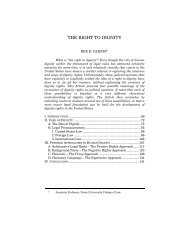A Right to Media? Lorie M. Graham - Columbia Law School
A Right to Media? Lorie M. Graham - Columbia Law School
A Right to Media? Lorie M. Graham - Columbia Law School
You also want an ePaper? Increase the reach of your titles
YUMPU automatically turns print PDFs into web optimized ePapers that Google loves.
2010] A RIGHT TO MEDIA? 483<br />
Just <strong>to</strong> be seen on TV makes people genuine in a way that<br />
almost nothing else in the 20th-century culture does. This<br />
is the psychological underpinning for the CRTC’s recent<br />
decision <strong>to</strong> grant a licence for an Aboriginal television<br />
network. Not only will the Aboriginal Peoples Television<br />
Network be a place for Native people <strong>to</strong> present themselves<br />
<strong>to</strong> one another in English, French and 15 Native languages,<br />
but it will be an electronic arena in which many Canadians<br />
will encounter Aboriginals in ways they might never do<br />
otherwise. 207<br />
While indigenous media in Canada still faces legislative<br />
marginalization and funding shortages, it has nevertheless been<br />
evolving for more than forty years. In the 1960s and 1970s, radio and<br />
television programming from non-indigenous sources began <strong>to</strong> be<br />
broadcasted in<strong>to</strong> aboriginal homes. 208 In response <strong>to</strong> the deluge of<br />
non-indigenous broadcasting, indigenous leaders pushed for<br />
government funding for Aboriginal media programming.<br />
In 1960, the Canadian Broadcast Corporation (CBC)<br />
Northern Service broadcasted, via studios in Montreal, the first<br />
Aboriginal language radio program. This marked only the beginning<br />
for Canadian indigenous radio, and by the 1970s sixteen percent of<br />
short-wave radio programming from Canada’s Northern Service was<br />
in Inuktitut. 209 With funding and technical support from the<br />
Canadian government and the CBC, radio was used throughout the<br />
North as a primary source of political and community information. In<br />
1971, the Canadian Department of Communications introduced the<br />
Northern Pilot Project, which allowed several Aboriginal<br />
communities <strong>to</strong> experiment with radio programming. 210 Due <strong>to</strong> the<br />
project’s success, the Native Communications Program (NCP) was<br />
initiated in 1973. The program was created <strong>to</strong> support local and<br />
stereotyping/aboriginal_people/aboriginal_broadcasting.cfm (last visited Feb. 5,<br />
2010).<br />
207. Edi<strong>to</strong>rial, The Native <strong>Media</strong>, Globe & Mail (Toron<strong>to</strong>), Feb. 24, 1999,<br />
at A14.<br />
208. <strong>Media</strong> Awareness Network, supra note 206. Rosemary Kuptana, the<br />
eventual president of the Inuit Broadcasting Corporation, compared the influence<br />
of non–indigenous television programming <strong>to</strong> the neutron bomb, stating that it<br />
“kills the people . . . but leaves the buildings standing.”<br />
209. Id.<br />
210. Id.















